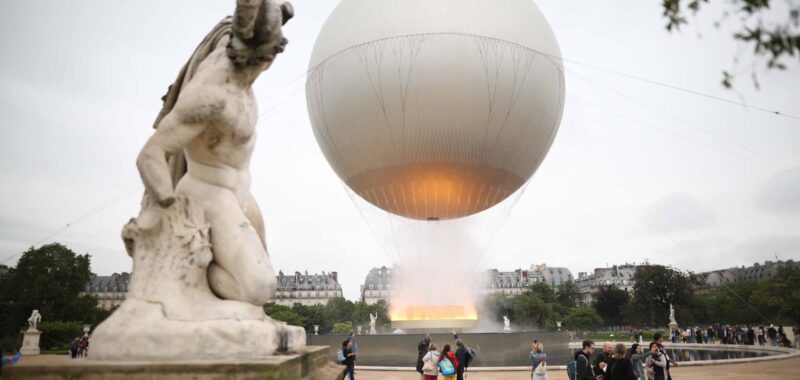Last Friday, the opening ceremony for the Paris Olympics paraded along the Seine before its dramatic conclusion. The final torchbearers, French athletes Teddy Riner and Marie-José Pérec, dipped the flaming Olympic torch into a cauldron reminiscent of a hot air balloon, which then drifted roughly 200 feet above the Jardin du Tuileries.
The Olympic Committee selected Mathieu Lehanneur from a series of applicants to design the cauldron, torch, and relay cauldron, citing the French designer’s “poetic and highly symbolic approach.”
Lehanneur imbued the trio with analogous designs. As a nod to the iconic medals, each piece dons a metallic shade somewhere in-between gold, silver, and bronze. The three objects, described by Lehanneur as “three chapters in the same story,” represent the French motto: Liberté, Égalité, Fraternité. The cauldron symbolizes Liberty, the torch stands for Equality, and the relay cauldrons indicate Fraternity. These tenets were incorporated into the narrative of the games’ opening ceremony.
The journey to the ceremony’s culmination at the Tuileries spanned thousands of miles across Europe and incorporated each Olympic object designed by Lehanneur—the torch, relay cauldrons, and cauldron. Back in April, the torch was lit in Ancient Olympia in Greece, before embarking to Marseille on a French, three-masted sailboat across the Mediterranean.
Since then, the Olympic flame has traveled to various stopover cities across France, each supplied with a relay cauldron. The relay cauldrons have a ring, supported by three beams, which holds the flame and features Lehanneur’s signature metal. There’s a rectangular base marked by a water-like texture. Ripples similarly clad the torch, inspired by the Seine and made of 100 percent recycled steel.
The nearly 100-foot final cauldron looks remarkably like a hot air balloon and stole the show with its spectacle. Here, Paris again pays homage to its past: In 1783, the first hydrogen-filled hot air balloon, designed by French physicist Jacques Charles, departed from the same gardens (before it was ripped to shreds by terrified townspeople upon landing.)
The Paris 2024 Olympic cauldron is lit!
Sorry, THE PARIS 2024 HOT-AIR BALLOON OLYMPIC CAULDRON IS LIT! #Paris2024 #OpeningCeremony pic.twitter.com/CIuS4RzfHD
— The Olympic Games (@Olympics) July 26, 2024
Unlike this earlier predecessor, Lehanneur’s design takes flight via tether and does not use a real flame to align with the Paris Olympics’s low carbon goals. This is the first time the Olympic flame shines without fuel. Described as a “ring of fire,” the base is more than 20 feet in diameter and uses 40 LED spotlights to illuminate a mist produced by high-pressure water nozzles. Each night, from sunset until 2 a.m., the cauldron will rise above Paris for the duration of the games.
Lehanneur described the cauldron as “magical and unifying, it will be a beacon in the night and a sun within reach during the day.”

